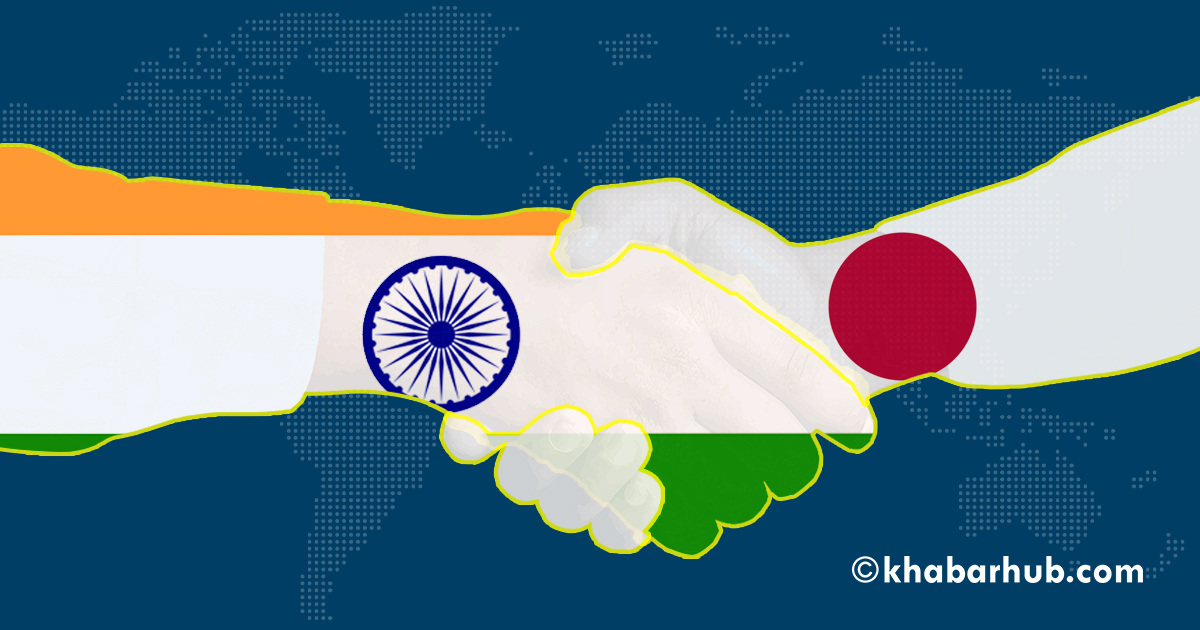COVID-19 has resulted in a global pandemic leading to a cyclical impact related to global financial situations that is further upturning the world economies and bringing healthcare facilities, in most countries, to a standstill.
China’s Wuhan emerged as the epicenter and soon, this virus spread like wildfire across the world that enabled the World Health Organisation (WHO) to declare it as a global pandemic. It has impacted many countries and their geopolitical, strategic and economic relations.
Prime Minister Narendra Modi recently said that “India-Japan special strategic and global partnership can help develop new technologies and solutions for the post-COVID world for our peoples, for the Indo-Pacific region and the world.”
In this context, the article tries to highlight the possible impacts of Coronavirus on India-Japan relations, in the wake of the COVID-19 pandemic.
Japan has been instrumental in pushing the manufacturing hub in India for the past few years, as it has been facing challenges like the shortage of manpower, higher costs of production and rising costs.
Due to the sudden increase in the number of COVID-19 cases, Japan has been badly hit, like China, its biggest trading partner’s imports slumped in mid-February leaving the supply chains shuttered and with many Japanese factories placed in China left hanging in mid-air.
This situation led to renewed talks of Japanese firms reducing their reliance on China as a manufacturing base. The Government panel also discussed its future course of actions, where it was discussed that high-value products should be shifted back to Japan and for other goods, the production must be diversified across Southeast Asia since the affected Japanese firms who had their factories located in China faced the disruption of the supply chains.
Japan earmarked USD 2.2. million economic stimulus package to help manufacturers shift production out of China and has put in an extra budget of 220 billion yen (USD 2 billion) for companies shifting back their production base to Japan.
Around 23.5 billion yen has been given to Japanese companies so that if they want they can move production to other countries and this is good news for India.
Japan’s plan of diversification of its supply chain means that India could be the first choice for Japan as India has been ranked as one of the most attractive investment destinations in a survey of Japanese manufacturing companies conducted by the Japan Bank for International Cooperation (JBIC), where India was ranked second in 2017.
Healthcare is yet another avenue that could secure benefits for both India and Japan. Japan has been actively involved in its mask diplomacy and has been providing protective gear to countries like China.
Japan has been instrumental in pushing the manufacturing hub in India for the past few years, as it has been facing challenges like the shortage of manpower, higher costs of production and rising costs.
With the decline in population and the steady fall in the number of young people, the domestic demand is low in Japan, which eventually led Japan towards China since China was a preferred destination due to its large markets, solid inflow of labor force, comparative ease of doing business and the shared common cultures, becoming Japan’s hub.
However, China’s constant ‘push and pull strategy’ or ‘hot and cold strategy’ towards Japan has made the country rethink this option and the recent slump in the supply chain has only strengthened Japan’s policy of shifting its manufacturing hub to a more stable democracy like India which would also help strengthen India’s flagship projects ‘Skill India and Make in India’.
Japanese FDI has increased to USD 2.965 billion in 2018-2019 from USD 1.6 billion in 2017-2018, which is a major sign in itself.
There has been significant growth in the number of Japanese affiliated companies in India, and in 2018, the number of Japanese companies registered in India has increased by 5.2 percent in comparison to 1,442 Japanese companies in October 2018 and most of these companies comprise of manufacturing firms.
There have been several projects in the manufacturing sector such as 12 Japan-India Institute of Manufacturing (JIM) in India established by the Japanese companies, 4 Japanese Endowed Courses (JEC) of Indian Engineering Colleges, National Skill Development Corporation (NSDC) has been nominated as the implementing body of Technical Intern Training Program (TITP) in India.
Likewise, India on its behalf also sent 161 TITP interns to Japan under job categories like machining, construction, factory sheet metal work, machinery and metals, automobile repair and maintenance, care-worker, welding and cultivation agriculture.
Another possible avenue between India and Japan would be digital partnership and technology transfer. Though this has already been taken forward by India and Japan’s Digital Partnership (I-JDP) focusing on cooperation on new initiatives within the scope of cooperation in S&T/ICT and “Digital ICT Technologies”.
They later initiated the Japan-India Startup Initiative and set up the first start-up hub in Bangalore and set up a fund to invest in technology start-ups in India with focus on Internet of Things, Artificial Intelligence, Machine Learning, fintech, healthcare, consumer, education, robotics, automation, and business-to-business (B2B) software.
Healthcare is yet another avenue that could secure benefits for both India and Japan. Japan has been actively involved in its mask diplomacy and has been providing protective gear to countries like China.
Japan has developed Avigan, an anti-viral produced by Japan’s Fujifilm Holdings Corp and alongside has been effective in the treatment of COVID-19.
India too has been working tirelessly to dole up medicines, and a lot of pharmaceutical companies although are feeling the pressure, have been effectively producing the same. Recently, India supplied hydroxychloroquine to the United States and has eased restrictions on exports of the drug for humanitarian purposes.
Together India and Japan can be leaders in healthcare facilities and equipment. It is for sure that under the great leadership and bonhomie amongst the leaders, India and Japan relations post-COVID would develop in leaps and bounds with the help of new technologies and solutions supporting the two countries, the Indo-Pacific region and the world at large.
India should also prepare itself for such opportunities by reforming the legal system to attract FDI and making flexible labor laws.
(The author is a Ph.D. candidate at the Department of East Asian Studies, University of Delhi. Currently, she is a Visiting Scholar at the University of Tokyo, Japan)









Comment